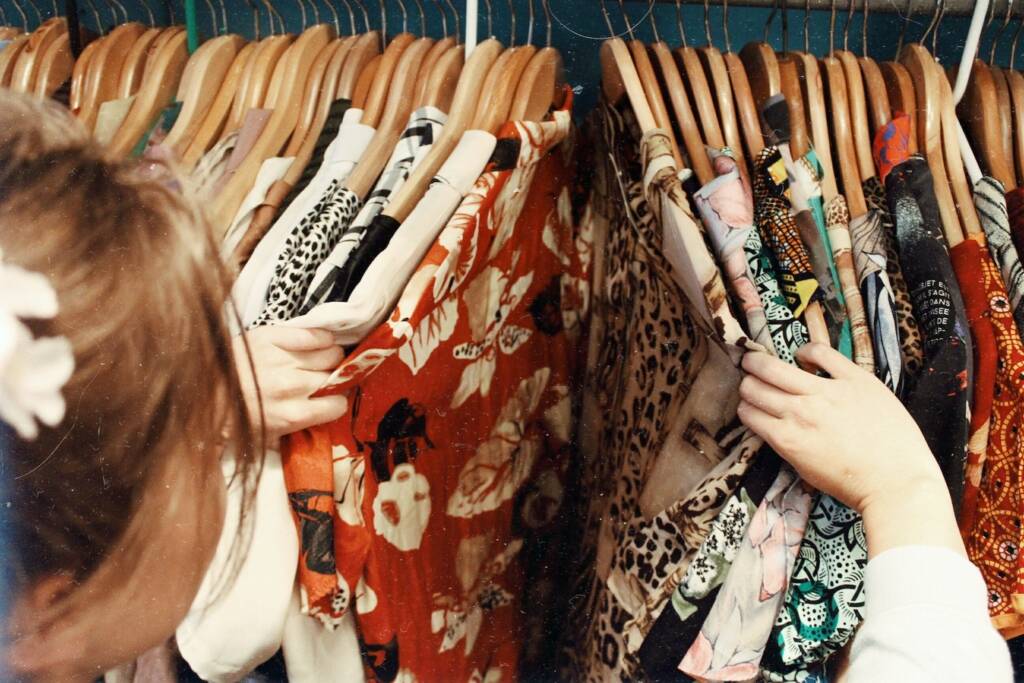Writing by Chelsea J. Stinnett // photograph by Becca McHaffie
 The way we dress reflects our identity. Style is shaped by interests, preferences, values, and more; clothing is how we express ourselves to the world. But a penchant for a specific style or trend doesn’t just come from you alone; it’s moulded by outside influences constantly shifting and evolving with time.
The way we dress reflects our identity. Style is shaped by interests, preferences, values, and more; clothing is how we express ourselves to the world. But a penchant for a specific style or trend doesn’t just come from you alone; it’s moulded by outside influences constantly shifting and evolving with time.
Just a few years ago, it seemed unthinkable that the Internet or social media could influence style. Now, apps like TikTok have been dominating fashion spaces and the industry. It’s how people determine what’s hot and what’s not, which changes how we express ourselves through style. Other priorities and issues much bigger than the individual also influence how we dress and where we find our clothes.
Here’s how changing trends and values are shifting fashion, identity, and self-expression:
Social media style
The rise of social media has exposed how much fashion can be a community affair. “Core” styles have become widespread on apps like TikTok, where these seemingly endless aesthetic subgenres are posted online for others to see. Styles like farmcore, angelcore, cottagecore, and even clowncore have all surfaced online accompanied by trending sounds and dance moves.
Though subcultures of fashion are nothing new, social media makes it easier to circulate worldwide. This makes it easier for people to come together and find a community that helps develop their style. “Core” fashion gives a name to a style, allowing people to find and hone their personal style and spin on the aesthetic.
Shifting trends
Fashion trends come, go, and return again, and we see that especially today with the rise of Y2K fashion and vintage pieces. But even though trends cycle, they’re never the same as when they first appeared in the fashion zeitgeist. Trends and pieces evolve with time and changing sentiments, which can pave the way for unique (if familiar) forms of self-expression.
Take the recent trend of sports sunglasses. Oakley became a pioneer in the field by creating and popularising protective eyewear for athletes in the ’80s and ’90s. But now, these sunglasses have shifted from performance-enhancing accessories to a unique fashion statement that can top your look. You don’t need to be an athlete to rock a pair; you can use them to add a touch of edgy, colourful coolness to your look if that’s something you want to express through style.
However, sometimes fashionable trends or traditions can stay the same, and it’s how we relate to them that may be altered. Many high school or college students find it wonderful to plan a sophisticated gown for prom night, and to enjoy the pomp and circumstance of such an event. How you make alterations, showcase your own culture, or celebrate a tradition among your friends is as unique as each person.
New values
Other than social media and trend cycles, fashion is linked to politics, society, and the values they mould in people. Take the example of climate change; the pressure to make environmentally friendly lifestyle changes pushed people to rethink their shopping choices. Sustainable shopping and clothing not only became famous but also became a necessity. The disdain toward the cheap, mass-produced clothing of fast fashion then encouraged more people to look for sustainable brands or turn to op shopping.
Rather than buying and styling new clothes, people search for pre-loved items—many vintage—which became a factor in personal style and self-expression. People could style, rework, or upcycle old pieces to suit their tastes instead of shopping at brands that were deemed unsustainable. Though the rise of op shopping has implications for fashion and the economy, it’s clear that sustainability values are changing how people shop, dress, and express themselves through clothing.
Fashion and its link to identity and self-expression don’t exist in a vacuum. So many forces come into play when we think about what we want to wear and what we want our clothes to say about us. When these things inevitably evolve, so will our style and how it reflects our identity.






